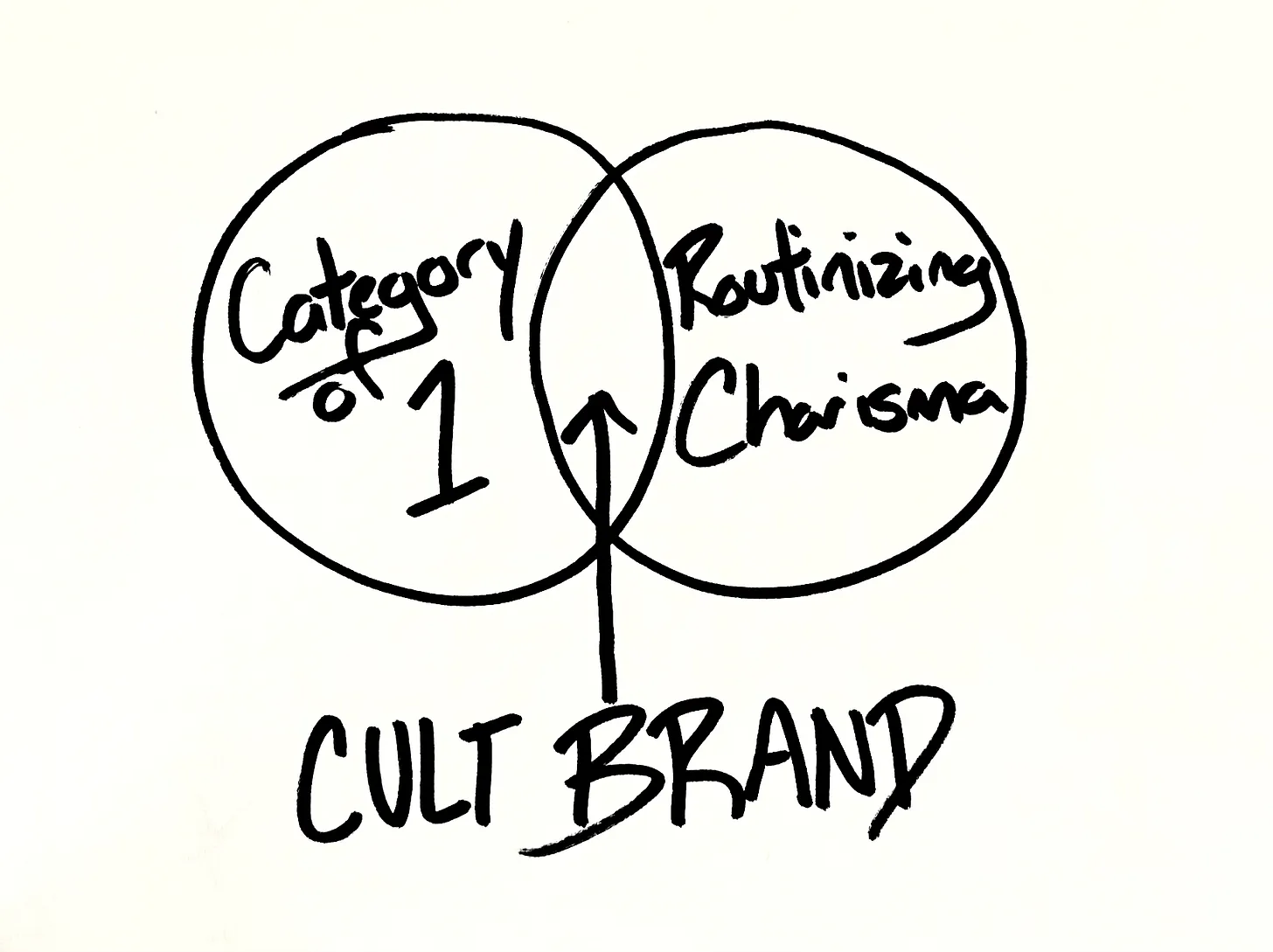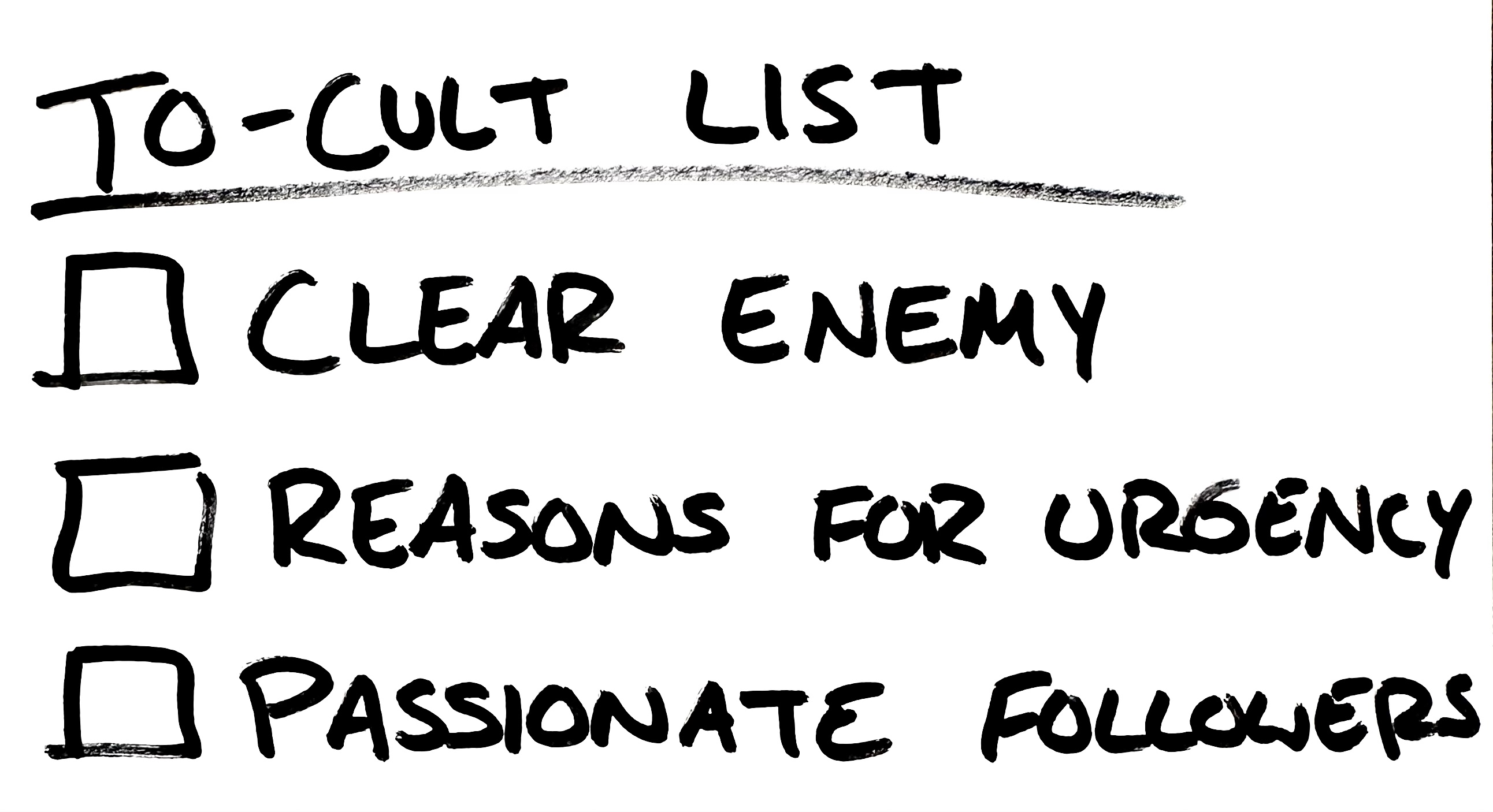❤️🔥 Cult Your Brand
If there were a year to transform your brand into a cult brand, 2023 would be it.
If you want a brand like Death Wish Coffee, Patagonia, or The Liver King (don't be like The Liver King), then you're looking for this:

But how do you get there?
Here’s a rough guide created by combining these 3 episodes of the Marketing Against The Grain podcast:
- How To Start A Cult Brand | Lessons From Peloton, Nike, and CrossFit
- How Liver King Fooled The World With Great Marketing
- Use This Marketing Framework To Build A Cult Brand
Cults 101
Let's start with real cults, the kinds your parents warn you about and every procedural show needs at least one episode about.
Why do people join cults? (And what brands might match up?)
- Offering a solution to societal problems (Patagonia, health brands)
- Gain a sense of belonging (Peloton, fitness brands)
- Low self-esteem (fashion brands (Chanel, Gucci, etc.))
- Seeking purpose (Nike)
A few more quick nuggets to keep in mind:
- Cults are based around a charismatic leader that uses “routinization of charisma”
- People join cults to discover their individuality and stay for the sense of belonging—come for “you,” stay for “us”
- Word of mouth is the most successful method for generating new members
- Successful cult brands become the status quo
So, to apply that to brands:

Let's get culting!
But first...
Be Marketing-Minded
There are 3 general focal points for marketing people:
- Leadership (of a category or market, etc.)
- Analytic Iteration & Data
- Storytelling & Messaging
The key is to be at the intersection of all 3. And doing that means focusing on a lot of little things.

Here’s an example, where the marketing-minded person will put out something “on trend, relevant, and super cool.”

The goal is to operate from that central point and make it part of your brand's DNA.
Be A Category of 1

To cult your brand, you need to redefine the category and/or differentiate the product.
If you can’t create a new category—or if you have a product that is “nothing” (NFTs, anyone?)— you need to create a truly unique experience that makes it seem as if you are in a class of your own. You can’t just take something that exists and make it slightly cooler, you need an experience. (According to Todd McFarlane, adding 3% sexy gets you over the tipping point into something new.)
Be Charismatic

How do you do that “routinization of charisma” thing?
What’s a daily / weekly / regular thing your community can galvanize and evangelize around?
Organized religions have regular services. Crossfit has a daily workout.
This ritual is a critical part of culting your brand. It also serves as a word-of-mouth generator since fans will talk about it.
Put It Together
Building a product has become commoditized. Distribution is where all the leverage is.
(Read that again, even if you aren’t trying to cult your brand)

If you want to go the extra mile, you need to identify a clear enemy for your brand to stand against.
At its core this will be the status quo, but you can get more explicit with it (like Pepsi vs. Coke).
Create urgency with clear reasons why this is important to do now.
It wouldn’t be a terrible idea to reference that list of 4 reasons why people join cults and see what you can align with. This is where the charismatic ritual comes in.
Now the easy part, cultivate a group of passionate followers that are rabid about your brand and help spread the word.
This is where the rubber meets the road. Everything before this was theory, this is where you have to turn your dreams into reality.
While not covered in these episodes, I would recommend picking one—or maybe a small handful—of channels to focus on to build your fanbase. Pick the medium that feels most natural and manageable, then find the channels that match up, and then get to work making and shipping.
Wash. Rinse. Repeat. Repeat. Repeat.
Build Your Pyramid

You need a clear vision—a clear point of view—on the problem you’re solving, in addition to solving it in a differentiated and better way.
This vision comes from the founder or CEO and sets the stage for the brand story.
Story can’t be an afterthought, it has to be part of this vision.
Sometimes companies are product-led, in those cases story can act as an accelerant and differentiator. A compelling story isn’t required from the jump (or at least the seed of one), but it certainly helps.
To be a successful company, you have to have a point of view around a real problem you’re solving and how it truly helps the people you’re trying to help and serve.
Less “we make shirts,” more “passionate fishers spend a lot of time in the sun, we make shirts to keep them burn-free so they can spend less time worrying about reapplying and more time focused on reeling in that next great story.”
Don’t worry, this doesn’t need to be the fully realized, end game vision. You don’t have to have it all mapped out. But you need to be clear about where you are now and have a plan for what the next steps will be. And the vision can evolve as the product iterates and grows over time.
Positioning builds off this clear vision by applying it to a clear, well-defined category.
So you’ll need to start by determining if you fall into an existing category or are creating a new one. Then you’ll need to know how you’re differentiating from what’s existing in the market / mind of the consumer. This step might be handled by a group at the company with roles similar to CEO, head of product, and head of marketing.
Messaging is how you communicate all this to your customers.
Turning the position you created into words that will resonate with your target market. And this is all in the hands of marketing. The more you get down to functional messaging the more the product people will likely take over, but keeping the brand peeps involved and in an ownership position can ensure cohesion.
The pyramid is upside down for a reason. Everything flows down from the vision, it is the base of the pyramid as far as foundational importance but top of the list as far as priority. Message is the tip because the entire thing balances and pivots on the strength of the messaging.
The Quick Version
- Foster a sense of both belonging and individualism.
- (Truly) Differentiate the product.
- Position and market against the status quo.
- Develop routine and ritual built on charisma and connection.
- Don’t drop the ball.